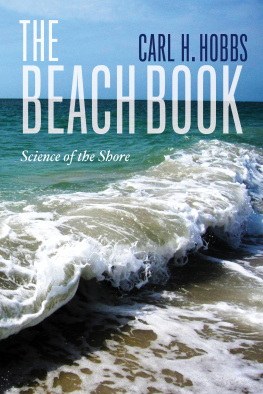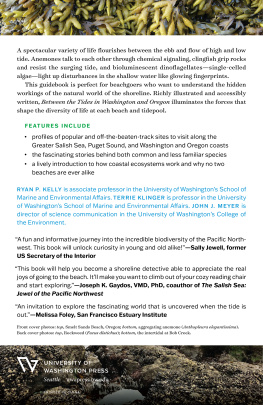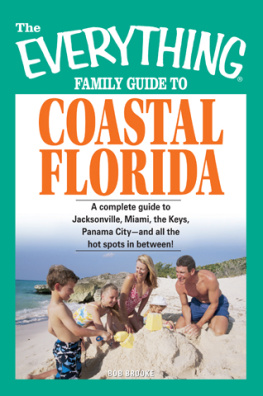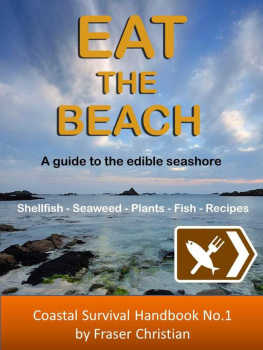THE BEACH BOOK
THE
BEACH BOOK
Science of the Shore
CARL H. HOBBS
 Columbia University Press New York
Columbia University Press New York

Columbia University Press
Publishers Since 1893
New York Chichester, West Sussex
cup.columbia.edu
Copyright 2012 Columbia University Press
All rights reserved
E-ISBN 978-0-231-50413-3
Library of Congress Cataloging-in-Publication Data
Hobbs, C. H. (Carl Heywood), 1946
The beach book : science of the shore / Carl H. Hobbs.
p. cm.
Includes bibliographical references and index.
ISBN 978-0-231-16054-4 (cloth : alk. paper)
ISBN 978-0-231-16055-1 (pbk. : alk. paper)
ISBN 978-0-231-50413-3 (ebook)
1. Beaches. 2. Coastal ecology. I. Title.
GB454.B3H63 2012
551.457dc23
2011047619
A Columbia University Press E-book.
CUP would be pleased to hear about your reading experience with this e-book at .
References to Internet Web sites (URLs) were accurate at the time of writing. Neither the author nor Columbia University Press is responsible for URLs that may have expired or changed since the manuscript was prepared.
The author of a book is more like the captain of a team than a solo operator. I could not have written The Beach Book without the encouragement and assistance of many individuals. The idea for the project evolved during a series of conversations with my daughter, Catherine Hobbs. Her involvement has continued as she helped edit chapters, contributed advice about the ways of the publishing industry, and encouraged me to continue working whenever the inevitable frustrations appeared. More than forty years ago, Miles Hayes introduced me to the study of coastal geomorphology and coastal processes. So, in a different sense, the book began with him. Patrice Mason drew several of the figures and provided encouragement and moral support while I worked on the manuscript. Throughout my career at the Virginia Institute of Marine Science (VIMS), I have learned from professional associations and friendships with many talented colleagues, including John Boon, Bob Byrne, Scott Hardaway, John Milliman, Jim Perry, John Wells, and Don Wright, among others. Susan Schmidts interest, encouragement, and labors as an editor substantially improved the manuscript. The project could not have gone forward without Patrick Fitzgerald, publisher for life sciences at Columbia University Press. Bridget Flannery-McCoy helped me navigate many of the details of publishing, and Irene Pavitt brought her superb skills as an editor to the book. I thank each of them and the many others who, in one way or another, contributed to my efforts in preparing the manuscript.
THE BEACH BOOK
The Beach Book describes the physical processes and materials that create and change the edge of the sea. Sunbathers who visit the shore on day trips or week-long vacations notice that the beach is different each time they return. It can be wide or narrow, pitch steeply or slope gently into the water, be rocky or sandy. Swimmers feel the currents. Many popular beaches are on barrier islands with sand dunes. Marshes that feed and shelter fish and crabs often are near beaches. Anglers and boaters navigate through tidal inlets, experience the roll of waves, and must remember the hours of high and low tides. Home buyers want to gauge erosion rates. The more we know about the physical processes that create, maintain, and erode beaches, the better we can appreciate the shore. This book presents basic geology and oceanography for interested readers.
I have worked mainly along the coasts of the Atlantic Ocean and Gulf of Mexico. However, the concepts and issues covered in this book apply to coastal systems worldwide. In all areas, tidal range, sediment characteristics and abundance, wave climate, and sea-level change work together to create and shape beaches. Even though the relative importance of each factor varies from place to place, the underlying physical rules do not.
Mathematics helps explain these physical rules, and this book presents some key equations about the forces that build and change beaches. While math might challenge some readers, every equation is clear and the accompanying text describes the relationships stated in the equations. Some readers might work through the math in the chapters on waves and tides, while others might be content with the text.
After an overview of beaches, the book considers wind. Wind can bring cold water to a hot beach in summer, and storms are named by the direction of their winds. Most important, wind generates waves, which move sand to shape beaches. While we look forward to splashing in the waves or surfing on them, waves also are the major agent of beach erosion. Similarly, tides play a major role in shaping beaches and in the dynamics of inlets between barrier islands. Sediments are the stuff of beaches, accounting for some of the differences among beaches in different locations.
The book then expands the discussion on beaches and integrates concepts to include a broader segment of the coast that is familiar to many beachgoers: the closely related barrier islands and inlets, and the very disparate sand dunes and tidal marshes. Barrier islands and tidal marshes, in particular, are very sensitive to changes in sea level. A worldwide social and political as well as environmental challenge, sea-level rise requires that not only marine scientists but also policy makers and citizens understand the geological processes that control sea level, the impacts of long-term changes in water level on coastal areas, and the projections for sea-level rise in the future. Storms and storm surges are powerful and fast-acting meteorological events with geological consequences. One of those effects is damage to the shore, including erosion. The book ends with a discussion of the tools used to resist erosion and the scientific and social factors to consider in deciding whether to combat it.
Because each chapter is written so that it can stand on its own, there is some repetition. By explaining the physical aspects of coastal systems, this book will help natural-resource managers make important decisions. Citizens will better understand public-policy options concerning the control of shoreline erosion, the restoration of eroded beaches, and the regulation of coastal-zone development.
The Beach Book will give readers a better appreciation of beaches, the areas around them, and the processes that shape the shore.
For many people, the beach is the shore. It is where they go to play in the sea, to sunbathe, to play beach volleyball, and to dance to beach music. In some uses, the words shore and beach are synonymous. An unemployed or a retired mariner is said to be on the beach. To the coastal scientist, however, a beach is a specific, physical environment. In Beaches and Coasts, Richard Davis and Duncan FitzGerald define it as a deposit of unconsolidated sediment, ranging from boulders to sand, formed by wave and wind processes along the coast. The beach extends from the base of the dunes, cliff face, or change in physiography seaward to the low-tide line.
Waves, currents, and wind move the sediments and shape the beach. The sediments at the beach are mobile, since they are both unconsolidated and noncohesive; that is they do not stick together. Beach sediments range in size from boulder to sand. The cohesive fine-grained sediments, silt and clay, do not play a significant role because they are unlikely to be deposited in the high-energy environment that helps create the beach. The shape of the beach is the response of the sediments to the physical forces of wind and water. The narrow, sandy strand is the buffer between the energetic sea and the relatively stable land. The beach changes form to accommodate fluctuations in the forces working on it. The shapes of the beach and the nearshore adjust during storms to dissipate energy. The coast responds to changes in the driving processes at a wide range of spatial and temporal scales. During a storm, the beach can change shape in an hour or less. It can take days or weeks for a beach to grow. The entire shore area can change over decades.









 Columbia University Press New York
Columbia University Press New York